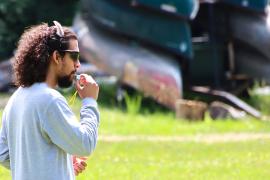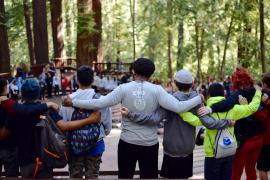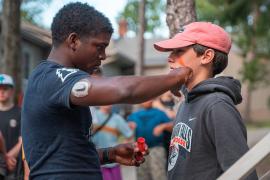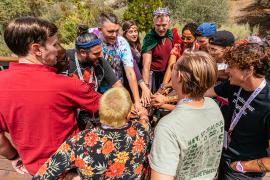In many ways, the majority of camps are alike. Camps are places deeply rooted in tradition and history, often with fields, sport and non-sport programs, water-based activities, and food programs. But at their core, all camps are different. Camps are defined by two major pieces: the people and the culture. Whether they are good or bad, both people and culture create each camp’s identity. From time to time, culture needs to be evaluated and sometimes there is a need for it to change. The change, arguably, is the easy part. The hard part is realizing and admitting it is needed.
Each year camp professionals work hard to improve upon the prior summer. New program areas are built, activities are created, entertainment is booked, orientation is tweaked and reshaped, and so much more. All of this impacts culture, but most of the time all of this is done on autopilot. Yearly and monthly to-do lists are taken out and checked off, emails are sent around the same time every year, and eventually everything is running like an oiled machine. Yet, like all machines, at some point and time, a new and improved model needs to be implemented.
Before talking about how to implement a change in culture, we must first talk about what culture is and does. At its core, culture is a definition. Culture defines and creates a sense of identity and belonging, allows for communication and self-expression, highlights history and tradition, relates to social norms and values and, (potentially above all), promotes innovation and creativity.
Saying vs. Doing
Change is hard, especially when it comes to culture. For your culture to change, you need to change with it. Saying you want to change your culture is easy — actually implementing the change is the challenging part. Identifying the key pieces you want to change and creating a plan on how to change those pieces is a good place to start, but before you can even do that, you must be able to change your personal mindset. You cannot implement change if you are not open to change. Surrounding yourself with a team that challenges you as much as you challenge them is a great place to start.
Creating Staff Buy-In for Change
The staff response of “that’s how it’s always been done” could be the number one deterrent to change. A good response: “Who cares?" Just because “that is how it has always been done,” does not mean it cannot be done another way. Certain aspects can change without changing the tradition and history that is so deeply rooted in camp. It is not always that it needs to be done another way, but it can be beneficial to analyze why and how something is being done and ask yourself and your team “How can this be done better?” or “What will changing this process impact? Will it create more problems or open new possibilities?" By having the same old thinking, you will get the same old results.
Most people think that it starts at the top. The truth is, anyone can initiate change, but only if the culture allows it. Having staff buy-in is very powerful, and staff are essential pieces in changing culture. For staff to be your eyes, your ears, and your voice, when it comes to all things change, they need to be empowered.
Traditional problem-solving of defining a problem, identifying a singular solution, and implementing that solution does not empower the people around you. For staff to feel empowered and as if they are making an impact and buy into change, a new way of thinking needs to be implemented. Integrative thinking is a great tool to get great results. Consider multiple — sometimes contradictory — viewpoints gathered by your staff and use them to create innovative solutions. By hearing all viewpoints, you will create a culture that promotes growth and enables adaptation.
Change Is Scary . . . That’s OK!
From the start of orientation through the last day of camp, one core principle we all try to accomplish is to help campers and staff step out of their comfort zone so they can learn and grow. For that to happen, key staff also need to be able to step out of their comfort zone. One of the best ways to lead is to lead by example. There are many roadblocks to stepping out of one’s comfort zone. The main one is fear of failure. But as we all teach throughout the summer, camp is a safe place to fail because you can either try again or try something new. If you implement something new, change how a program operates or change the time of a certain staff meeting, and it doesn’t work, it is important to reflect on why that change didn’t work and then possibly change it again! Who says you can’t do that? Don’t be afraid to fail, because within that failure, a new solution could possibly be found.
Surveys
The best way to get a pulse on how your culture is doing is by surveying. Most camps have three audiences: campers, parents and staff. Survey them all and survey them multiple times. Get a sense of what each audience is looking for and then evaluate what expectations are realistic, which are goals, and which are impossible. If you envision the culture you want, while taking into consideration what your audience(s) are asking and looking for, there will be nothing stopping you from being successful when it comes to your culture.
TLDR
Don’t be afraid to change something. If it doesn’t work, that is OK. Surround yourself with people who are going to challenge you. Talk to others and see how they are changing, check in with your audience(s), create a space where campers and staff are buying into what you are offering. If you want or think your culture needs to change, you need to be willing to change yourself; the small changes you make today will have a big impact on your culture tomorrow.
This blog was written on behalf of Project Real Job, whose purpose is to support camps in their efforts to recruit, hire, and retain staff.
Photo courtesy of Camp Carson in Princeton, IN
Max Grossman ([email protected]) has lived and breathed camp since the age of seven when he first attended day camp in New Jersey. Since then, he has spent every summer at camp, intent on one day being a camp director. After graduating from Towson University with a degree in Psychology with a focus on Child Development, he joined the full-time team at a day camp on Long Island as the Operations and Special Events Director. From there, Max spent five years at Camp Watitoh, a co-ed sleepaway camp in the Berkshires. Alongside his fiancé Nikki, Max is currently the Assistant Director at Point O’Pines Camp, an all-girls camp in the Adirondacks. Max is an active member of the American Camp Association, NY & NJ, serving on the Tri-State CAMP Conference committee, is an ACA Standards Visitor, and is a past member of the Emerging Professionals in Camping (EPIC) Committee. Max is also an active member of SCOPE (Summer Camp Opportunities Promote Education).
The views and opinions expressed by contributors are their own and do not necessarily reflect the views of the American Camp Association or ACA employees.




